Considering the size of our yard, we have a fair number of trees. But considering the importance of large trees, I wish we had space for more.
Although I like flowers as much as anyone, I’m trying to limit our flower beds in favor of more trees and shrubs.

Just as an apartment building houses many more people than a single dwelling on the same piece of land, a large tree can provide much more habitat and other ecological benefits than can a flower bed.
Of course, herbaceous plants are indeed important for pollinators, as host plants for butterflies, and so on. And herbaceous plants in turn provide so many more benefits than does turf grass.
Roots!

We didn’t plant this large sugar maple (shown above). It was planted when the house was first built back in 1940, and I’m sure it seemed like a good idea to plant what must have been a small tree at the time within just a few feet of the curving sidewalk leading up to the front door.
By the time we moved in, though, (in the 1980s) the large roots had buckled three slabs of the concrete and it had been a tripping hazard for the last forty years.
No more!
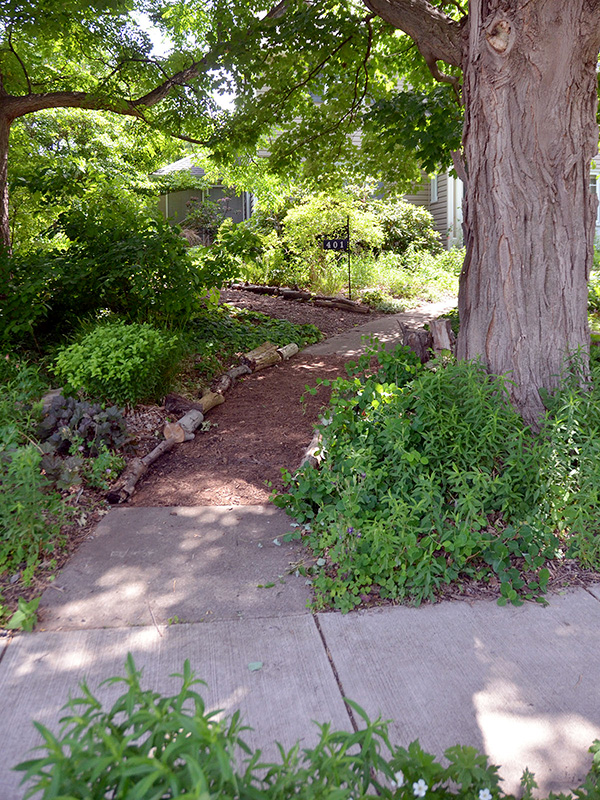
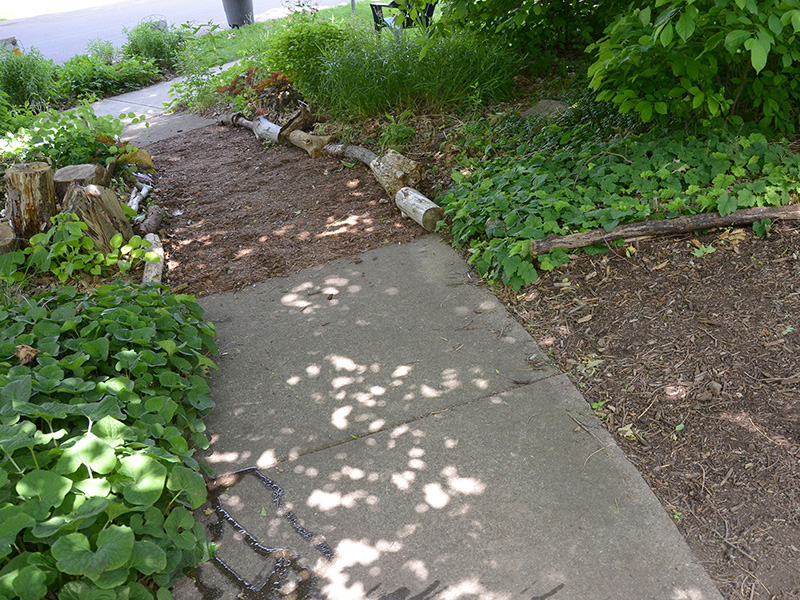
We explored different options including a method where they pump foam under the slabs to even them up or removing the entire sidewalk and/or replacing it. But we wanted to make sure we didn’t harm the tree roots in the process, so we had someone break up the three slabs and replaced the space with mulch to match our other paths.
We left the remaining concrete slabs for the sidewalk in place, especially since concrete represents a lot of embodied energy. Sometime in the future, if the maple tree dies, these three slabs can be replaced. So far, we’re happy with our choice.
The lesson, though, is to consider where you plant large canopy trees! I’ve read in Tallamy’s book that roots of certain oak trees grow down rather than out, so the particular tree species is an important consideration. And it’s always a great choice to plant an oak!
The easiest landscaping choice
The ecological advantages of trees is good news as we get older and want to spend even less time maintaining gardens.
How much easier can it be than to have trees and shrubs instead of the sometimes more labor-intensive flower beds?
We’re choosing trees and shrubs that will fit the available space and not need to be pruned frequently. Trees are something we can just plant once (or even hire someone to do it), water the first few years, and then sit back and enjoy the tree and the life it supports.
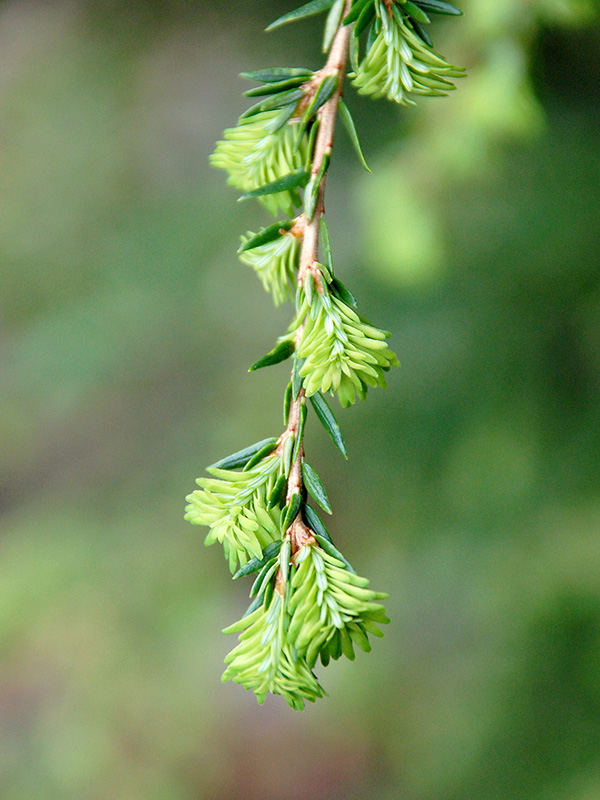
A bias against big trees
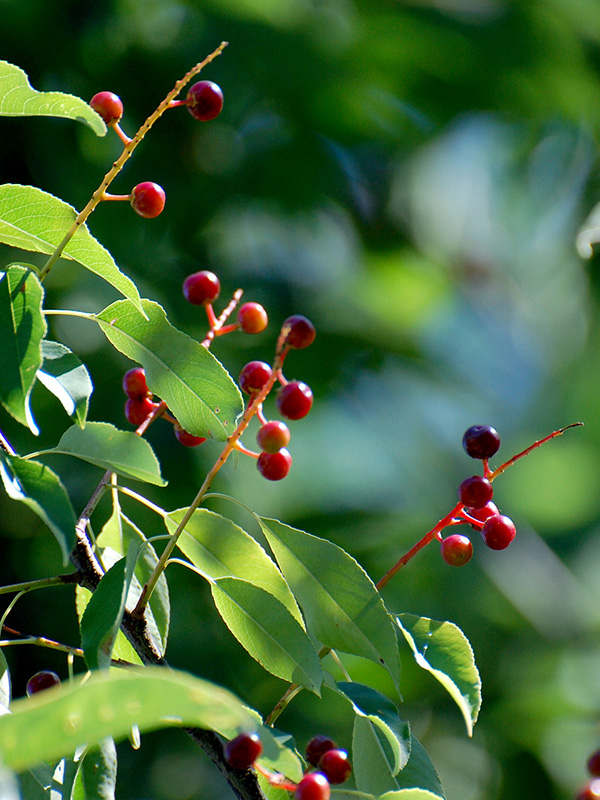
There seems to be a bias against planting large trees, native or otherwise.
Unfortunately, one of the most valuable trees (meaning it supports a lot of life) is nevertheless considered a “weed”: the black cherry (Prunus serotina).
Even a book on native plants described it this way:
It is not a species that you would plant, but if you have a tree in an advantageous location, you can enjoy the interesting summer flowers, outstanding fall color, and distinctive “potato chip” bark. The fruits, while messy, are relished by birds and that alone may be a good reason to keep a tree on your property. It is also a host plant for many beautiful butterflies.
So let’s see: interesting flowers, outstanding fall color, distinctive bark, fruits relished by birds, and host plant for many beautiful butterflies. So why is it “not a species you would plant”?
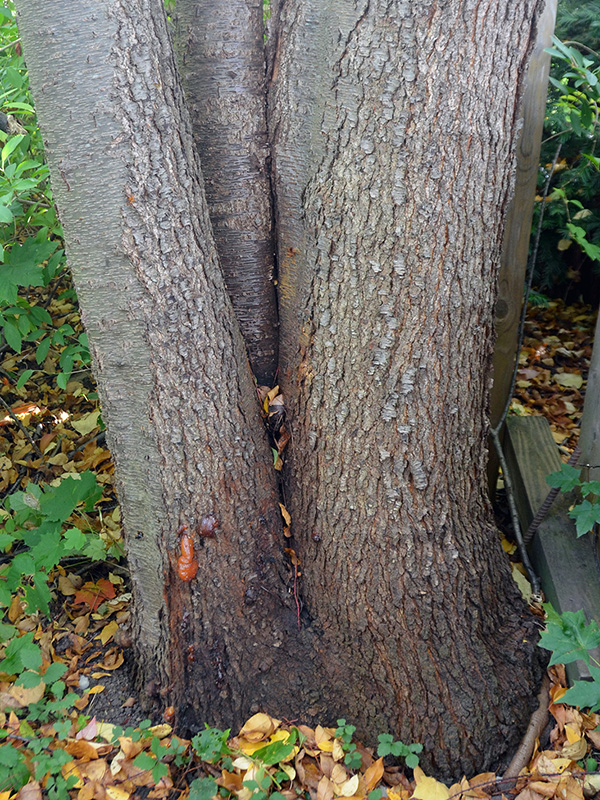
We were fortunate to have a small six-foot black cherry tree on our property when we moved in, though we didn’t know what it was. We just let it grow and later discovered it was a black cherry.
It’s been a wonderful habitat plant, providing not just spring nectar and summer berries but also — as one of Tallamy’s top trees — food for caterpillars!
Had we known its value, we wouldn’t have let it develop a weak triple trunk. We may have to eventually chain the trunks together, but we hope it lasts a good long time.
Raking leaves?
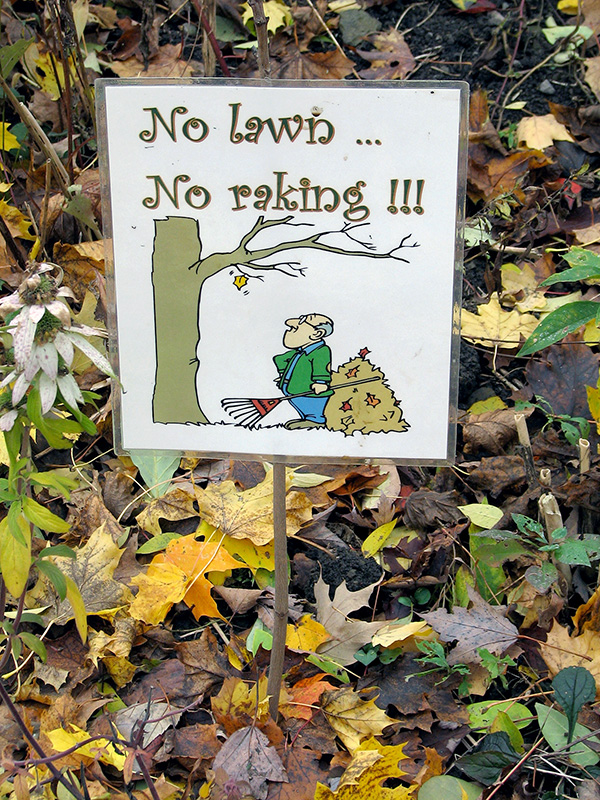
Many people don’t want trees because they don’t want to rake leaves.
Not a problem. Leaves are a problem only for lawns. We have so little lawn that it’s not difficult to rake or use a mulching mower.
(Note: You can download and print this sign.)
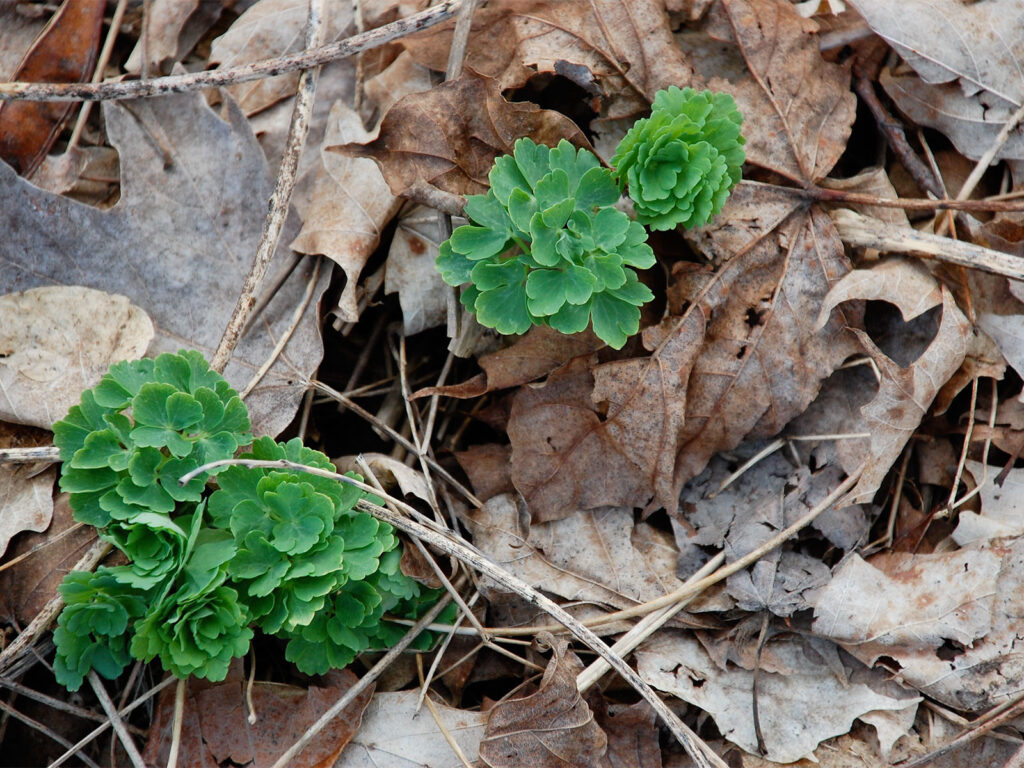
We just let the rest of the leaves decompose in place. Just as in the forest, our plants, such as these columbines, emerge through the decomposing leaves in the spring.
Is it a tree or a shrub?
As Scott Zona, author of A Gardener’s Guide to Botany says,
“… there is no botanical definition of a tree or shrub. We typically think of trees as large plants with a single, woody trunk. Shrubs can be large (but not as large as trees) and have one or more main stems. There is considerable overlap in these loose categories… Most of the time, we can just rely on common sense. You can stand in the shade under a tree; you can’t stand under a shrub.”
HERE is a list of the trees in our habitat garden.
Resources
- Tallamy:
- Choose Natives:
- USDA Forest Service:
- National Wildlife Federation:
- Ten favorite trees for wildlife – (Confirm they’re native to your own area)
- Wild Seed Project:
- Creating canopy: Plant a native tree for a greener future – Native to CNY, too
- Ecological Landscape Alliance:
- Notable natives: Large shrubs and small trees
- Helical piles – protecting trees and soil during construction
- White Oak Nursery:
- The Humane Gardener:
- NY Times:
- Why the best trees aren’t always the biggest – Understory trees
- Univ. of Minnesota Extension:
- Univ. of NH Extension:
- Durham NC Master Gardeners:
- Native mid-level trees for a bird-friendly garden – Plants mentioned are for the Southeast, but the concept applies in CNY, too
- PennState Extension:
- VIDEO: Tree shelter cages -specifically for stream side, but would work anywhere
- SUNY-ESF:
- VIDEO: Dendrology on YouTube – A series of 2-minute videos covering about 150 trees (mostly native), produced by Donald Leopold, author of Native Plants of the Northeast,
- VIDEO: Bringing back the American chestnut – This research is attempting to bring back the chestnut by adding a gene to make it resistant. Is this a good idea? Only time will tell.
- Science Friday:
- VIDEO: The American Chestnut
- Native Plant Trust:
- Cavity Conservation:
- VIDEO: This organization – lots of tips about safely keeping dead or dying trees
- NYS DEC:
- VIDEO: Pruning trees
- VIDEO: Winter is a good time for pruning trees
- Joe Gardener:
Reflections
And don’t forget that plants are long-lived. The white oak you plant tomorrow could easily live 300 years, servicing innumerable insects, birds, squirrels, mice, raccoons, and deer every year of its life.
~ Douglas Tallamy, Bringing Nature Home: How Native Plants Sustain Wildlife in Our Gardens, p. 230-31
I race outside as soon as I hear one hit, trying to beat the squirrels and the chipmunks to the oak tree’s bounty. It’s unseemly for a grown woman to be racing chipmunks for chipmunk food, but I’m collecting acorns for a good reason. …
Maybe it seems pointless, all this hope based on nothing more than a couple dozen acorns. Even if they all germinate, even if they survive rabbits and drought long enough to reach acorn-bearing age, how much difference will it make? In the context of rampant deforestation and massive biodiversity loss, will it matter if one small neighborhood in one growing city becomes a safe place for oak trees and the creatures they shelter and feed?
My answer lies in the acorn itself: As the old English proverb goes, mighty oaks from little acorns grow.
But a lot, I admit, depends on what happens next. “We hope that society as a whole can rethink its attitudes. Simple, everyday acts can go a long way,” [said] João Víctor Gomes de Oliveira …. If planting an oak tree is the first small step in rethinking everyday life, it could matter a lot.
~ Margaret Renkl, “Why we should all be chasing acorns” NYTimes, Oct. 2022
… [A]bout 75% of the insect food required by birds and other animals is produced by just a few plant genera. In most U.S. counties, oaks, cherries, willows, birches, hickories, pines, and maples are producing the vast numbers and types of insects that support animal populations. These tree genera are keystone plants because they play the same support role that the keystone in a Roman arch plays. In place, the keystone supports all the other stones in the arch, but take the keystone away and the arch collapses. The same is true for keystone plants; if you have an oak or black cherry or black willow in your yard, there will enough insect food for at least a few birds to reproduce. But a yard without keystone plants will fall far short of the insect abundance necessary to sustain viable food webs, even if dozens of native plant genera are present.
~ Doug Tallamy, The Nature of Oaks, p. 38 (2021)
Anybody can dig a hole and plant a tree. But make sure it survives. You have to nurture it, you have to water it, you have to keep at it until it becomes rooted so it can take care or itself. There are so many enemies of trees.
~ Wangari Maathai, “This Much I Know”, The Observer Magazine, June 2008
It’s the little things citizens do. That’s what will make the difference. My little thing is planting trees.
~ Wangari Maathai, Nobel Peace Prize Laureate
As the poet said, “Only God can make a tree” — probably because it’s so hard to figure out how to get the bark on.
~ Woody Allen
